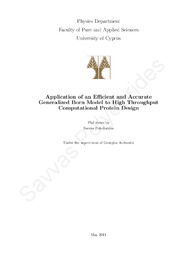| dc.contributor.advisor | Αρχοντής, Γεώργιος | el |
| dc.contributor.author | Πολυδωρίδης, Σάββας | el |
| dc.coverage.spatial | Κύπρος | el |
| dc.coverage.spatial | Cyprus | en |
| dc.creator | Πολυδωρίδης, Σάββας | el |
| dc.date.accessioned | 2012-09-21T07:35:22Z | |
| dc.date.accessioned | 2017-08-03T10:38:48Z | |
| dc.date.available | 2012-09-21T07:35:22Z | |
| dc.date.available | 2017-08-03T10:38:48Z | |
| dc.date.issued | 2011-05 | |
| dc.date.submitted | 2011-05-30 | |
| dc.identifier.uri | https://gnosis.library.ucy.ac.cy/handle/7/39426 | en |
| dc.description | Περιέχει βιβλιογραφία. | el |
| dc.description | Αριθμός δεδηλωμένων πηγών στη βιβλιογραφία: 211 | el |
| dc.description | Διατριβή (Διδακτορική) -- Πανεπιστήμιο Κύπρου, Σχολή Θετικών και Εφαρμοσμένων Επιστημών, Τμήμα Φυσικής, 2011. | el |
| dc.description | Η βιβλιοθήκη διαθέτει αντίτυπο της διατριβής σε έντυπη μορφή. | el |
| dc.description.abstract | Στην παρούσα διατριβή αναπτύσσουμε, ελέγχουμε και χρησιμοποιούμε μεθοδολογικές καινοτομίες και στα δύο ανωτέρω συστατικά. Αναφορικά με τις συναρτήσεις βαθμολόγησης, υλοποιούμε ένα ακριβές και υπολογιστικά αποδοτικό πρότυπο περιγραφής των αλληλεπιδράσεων του διαλύτη, το οποίο βασίζεται στη γενικευμένη προσέγγιση Born (GB). Αναφορικά με την εξερεύνηση του χώρου δομών / ακολουθιών, υλοποιούμε και ελέγχουμε δύο κριτήρια: (i) το κριτήριο της «απόλυτης ισχύος δέσμευσης», το οποίο εντοπίζει αλληλουχίες και δομές που ελαχιστοποιούν την ελεύθερη ενέργεια σχηματισμού βιομοριακού συμπλόκου μεταξύ μιας πρωτεΐνης και ενός συγκεκριμένου μορίου-υποκαταστάτη, και (ii) το κριτήριο της «σχετικής ισχύος δέσμευσης», το οποίο εντοπίζει αλληλουχίες / δομές που ελαχιστοποιούν τη διαφορά της ελεύθερης ενέργειας σχηματισμού μεταξύ δύο συμπλόκων.
Η ακρίβεια του προτύπου GB που χρησιμοποιούμε πιστοποιείται πρώτα μέσω σύγκρισης με υπολογισμούς Poisson, που μελετούν στερεοδιαταξικές αλλαγές και μεταλλάξεις σε μια σειρά πρωτεϊνών. Το πρότυπο GB συνδυάζεται με ένα πρότυπο ατομικής ακρίβειας για τις αλληλεπιδράσεις μεταξύ πρωτεϊνικών ατόμων, και χρησιμοποιείται για τον υπολογισμό ελευθέρων ενεργειών δέσμευσης σε μια σειρά από μεταλλαγμένα σύμπλοκα των πρωτεϊνών «Συνθετάση Ασπαρτικού οξέος» και «Συνθετάση Τυροσίνης». Κατόπιν, η συνάρτηση ενέργειας εφαρμόζεται σε ένα συγκεκριμένο βιολογικό πρόβλημα που σχετίζεται με το γενετικό κώδικα, τον ανασχεδιασμό της πρωτεΐνης «Συνθετάσης Ασπαραγίνης» (AsnRS), έτσι ώστε να έχει εξειδίκευση για το αμινοξύ Ασπαρτικό οξύ, αντί για το φυσιολογικό υποκαταστάτη, Ασπαραγίνη.
Το πρωτόκολλο που αναπτύξαμε (το πρότυπο GB, σε συνδυασμό με τα κριτήρια απόλυτης και σχετικής ισχύος δέσμευσης), εισάγει στην περιοχή δέσμευσης της AsnRS μεταλλάξεις με καλές φυσικές και χημικές ιδιότητες. Η τροποποιημένη περιοχή είναι δομικά σταθερή, όπως επιβεβαιώνεται από προσομοιώσεις ατομικής ακρίβειας, διάρκειας πολλών ns. Eπιπρόσθετα, πολλές από τις σχεδιασμένες ακολουθίες έχουν τη ζητούμενη αντεστραμμένη εξειδίκευση, δεσμεύοντας ισχυρότερα το Ασπαρτικό οξύ σε σχέση με την Ασπαραγίνη. | el |
| dc.description.abstract | Computational Protein Design (CPD) is a very promising state of the art methodology for high-throughput protein and ligand mutagenesis studies. It has been continuously developed in recent years by numerous studies, which address its essential ingredients: the algorithms employed to search the vast sequence / conformational space and the scoring functions, used to assess different sequences and conformations. In the present thesis we introduce and test methodological advances in both of the above ingredients. With respect to the scoring function, we implement an accurate and computationally efficient model of solvent effects, based on the generalized Born approximation. With respect to the exploration of the sequence / conformation space, we implement and test two criteria: (i) an absolute affinity criterion, which identifies protein sequences that minimize the association free energy of a protein and a specific molecule (ligand); (ii) a relative affinity criterion, which identifies protein sequences
that minimize the association free energy difference betwen two complexes. The accuracy of our solvent model is first tested against a benchmark Poisson model of continuum electrostatics, by calculations that introduce conformational changes and a broad set of mutations in a series of proteins. We then combine our solvent treatment with an atomic-detail representation of solvent interactions and test it further on binding-affinity calculations for several point mutants of the Aspartyl-tRNA synthetase and Tyrosyl-tRNA synthetase. We finally apply it on a specific design problem, the change in amino acid specificity of the protein Asparaginyl-tRNA synthetase (AsnRS). The engineered amino acid binding site of AsnRS contains physically reasonable mutations and is structurally robust, as verified by the conformational stability of the designed sequences during multi-ns molecular dynamics simulations. Furthermore, several of the sequences demonstrate a reverse specificity, favoring the target amino
acid aspartic acid over the native amino acid asparagine. These results suggest that our model and the combined stability / affinity criteria employed here constitute improvements to earlier CPD studies of modified AsnRS specificity. The design is not absolutely successful, as experimental activity measurements with some of the proposed sequences fail to show activity for aspartic acid. Nevertheless, these experimental results are consistent with our design. A second, application of our solvent treatment studies a problem that is related to CPD, protein acid / base equilibria. For a test set of six proteins and 78 titratable groups, the model performs well, with a reasonable rms error. | en |
| dc.format.extent | xviii, 210, [7] p. | en |
| dc.language.iso | gre | en |
| dc.publisher | Πανεπιστήμιο Κύπρου, Σχολή Θετικών και Εφαρμοσμένων Επιστημών / University of Cyprus, Faculty of Pure and Applied Sciences | |
| dc.rights | info:eu-repo/semantics/openAccess | en |
| dc.rights | Open Access | en |
| dc.subject.lcsh | Proteins Structure | en |
| dc.subject.lcsh | Protein engineering | en |
| dc.subject.lcsh | Models, Molecular | en |
| dc.subject.lcsh | Biophysics | en |
| dc.title | Ανάπτυξη και εφαρμογή ενός αποδοτικού και ακριβούς προτύπου έμμεσου διαλύτη της γενικευμένης προσέγγισης Born στον υπολογιστικό σχεδιασμό πρωτεϊνών | el |
| dc.title.alternative | Application of an efficient and accurate generalized Born model to high throughput | en |
| dc.type | info:eu-repo/semantics/doctoralThesis | en |
| dc.contributor.committeemember | Ηλιόπουλος, Ηλίας | el |
| dc.contributor.committeemember | Πτωχός, Φώτιος | el |
| dc.contributor.committeemember | Τούμπας, Νικόλαος | el |
| dc.contributor.committeemember | Προμπονάς, Βασίλης | el |
| dc.contributor.committeemember | Iliopoulos, Ilias | en |
| dc.contributor.committeemember | Ptochos, Fotios | en |
| dc.contributor.committeemember | Toumbas, Nicolaos | en |
| dc.contributor.committeemember | Promponas, Vasilis | en |
| dc.contributor.department | Πανεπιστήμιο Κύπρου, Σχολή Θετικών και Εφαρμοσμένων Επιστημών, Τμήμα Φυσικής | el |
| dc.contributor.department | University of Cyprus, Faculty of Pure and Applied Sciences, Department of Physics | en |
| dc.subject.uncontrolledterm | COMPUTATIONAL PROTEIN DESIGN | en |
| dc.subject.uncontrolledterm | IMPLICIT SOLVENT MODELS | en |
| dc.subject.uncontrolledterm | GENERALIZED BORN MODEL | en |
| dc.subject.uncontrolledterm | POISSON BOLTZMANN CALCULATIONS | en |
| dc.subject.uncontrolledterm | MOLECULAR DYNAMICS SIMULATIONS | en |
| dc.subject.uncontrolledterm | ASPARAGINYLTRNA SYNTHETASE | en |
| dc.subject.uncontrolledterm | AMINOACYL-TRNA SYNTHETASES | en |
| dc.subject.uncontrolledterm | GENETIC CODE | en |
| dc.subject.uncontrolledterm | PROTEIN-LIGAND INTERACTIONS | en |
| dc.identifier.lc | QP551.P69 2011 | en |
| dc.author.faculty | Σχολή Θετικών και Εφαρμοσμένων Επιστημών / Faculty of Pure and Applied Sciences | |
| dc.author.department | Τμήμα Φυσικής / Department of Physics | |
| dc.type.uhtype | Doctoral Thesis | en |
| dc.rights.embargodate | 2011-05-30 | |
| dc.contributor.orcid | Αρχοντής, Γεώργιος [0000-0002-7750-8641] | |



